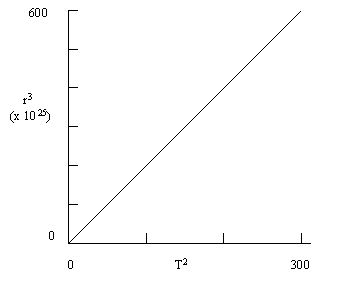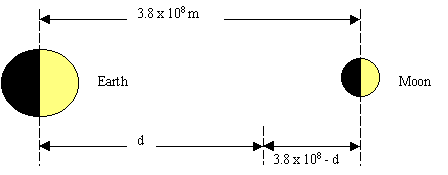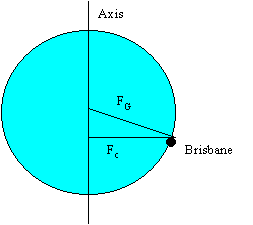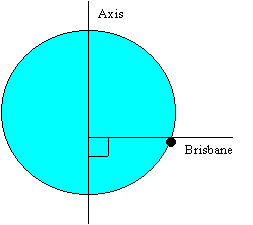Chapter 4 - Worked Solutions
to selected extension questions from the OUP text Senior Physics -
Concepts in Context by Walding, Rapkins and Rossiter
Question 49
t2 (above the surface) = 2t1 (on surface)
s1 = ut1 + ½ g1t12
s1 = ut2 + ½ g2t22
Because u = 0 and because both sides are equal to s1 then g1t12 = g2t22
9.8 t12 = g2 t22
9.8 t12 = g2 (2t1)2
g2 = 2.45 ms-2
Alternatively: on the surface, the time to fall 1.5 m from rest can be calculated from:
s1 = ut1 + ½ g1t12
1.5 = 0 + ½ x -9.8 t12
t1 = 0.553 s
As t2 = 2 t1 then t2 = 1.107 s
s1 = ut2 + ½ g2t22
1.5 = 0 + ½ x g2 (1.107)2
g2 = 2.45 s
g = Gm/d2
d2 = Gm/g = 6.67 x 10-11 x 6 x 1024/2.45 = 1.6 x 1014
d = 1.28 x 107 m
Distance above Earth = 1.28 x 107 m - 6.38 x 106 = 6400 km
Question 50
The relationship to consider is: g µ
m/d2
(a) half the mass but the same radius (or twice mass and twice radius etc).
(b) if t is twice normal then g would be ¼ normal, therefore: double the radius; keep mass constant.
(c) same as for answer (b)
Question 51
g(surface) = Gm/d2 = Gm/(5.1 x 106)2 = Gm/(2.6 x 1013)
g(above surface) = Gm/d2 = Gm/(5.1 x 106 + 150 x 103)2 = Gm/(2.76 x 1013)
g(above surface)/g(surface) = 2.6 x 1013/2.76 x 1013 = 0.94
Question 52
|
r3 |
T2 |
|
7.5 x 1025 |
3.13 |
|
30.2 x 1025 |
12.60 |
|
122.5 x 1025 |
51.27 |
|
664.4 x 1025 |
278.89 |

Graph is linear (passes through origin) hence r3 µ
T2
Question 53
(a)

FMoon = FEarth
G mem/d2 = Gmmm/(3.8 x 108 - d)2
6 x 1024/d2 = 7.34 x 1022/(3.8 x 108 - d)2
Take square roots of both sides:
2.45 x 1012/d = 2.71 x 1011/(3.8 x 108 -d)
9.31 x 1020 = 2.45 x 1012 d = 2.71 x 1011 d
9.31 x 1020 = 2.72 x 1012 d
d = 3.42 x 108 m
(b) 0.89 of the distance to the Moon
(c) NO! In circular orbit you would experience free-fall and feel weightless.
Question 54
(a) g = Gm/d2 = 6.67 x 10-11 x 6 x 1024/(6.38 x 106 + 10000)2 = 9.8011 ms-2
No noticable difference.
(b) Same as on the Earth's surface - no difference.
Question 55
(a) g = Gm/d2 = 6.67 x 10-11 x 2.0 x 1030/(12 x 103)2 = 9.2 x 1011 ms-2
(b) v = 2p
r/T = 2 p
x 12 x 103/0.041 = 1.84 x 106 ms-1
ac = v2/r = (1.84 x 106)2/ 1.2 x 103 = 2.8 x 108 ms-2
Question 56
Spring clock would not be affected by gravity and therefore will keep time. A pendulum is affected by gravity and won't keep time. The greater the gravitational force the faster the pendulum will oscillate.
Question 57

re = 6.38 x 106 m
rb (radius for Brisbane) = re cos 28°
= 6.38 x 106 x cos 28°
= 5.63 x 106 m
(a) circumference = 2 p
r = 2 p
x 5.63 x 106 = 3.54 x 107 m
(b) v = s/t = 3.54 x 107/ (24 x 3600) = 410 ms-1
(c) ac = v2/r = 4102/5.63 x 106 = 0.030 ms-2
(d) FC = mac = 60 x 0.030 = 1.79 N
(e) (i) Gravitational force FG points towards the centre of the Earth (see figure that follows):

(ii) Perp. to Earth's axis through Brisbane (see figure that follows):

(iii) Perp. to Earth's axis through Brisbane (see figure for (ii) above).
Question 58
v = √(2Gm/r) = √(2 x 6.67 x 10-11 x
1.4 x 1011 x 2 x 1030)/(80000 x 3600 x 24 x 365 x 3 x 108)
= (3.73 x 1031)/(7.57 x 1020) = 4.93 x 1010
m/s (greater than "c" so can't escape).
Question 59
r = 9.4 x 106m
T = 7h 39m = 7.65h = 2.754 x 104 s
v = √(2pr/T)
= (5.9 x 107/(2.754 x 104) = 2.14 x 103
m/s
Fc= mv2/r = Gm1m2/r2
v2 = Gm/r
m = v2r/G = (2.14 x 103)2 x 9.4 x 106/(6.67
x 10-11)
m = 6.475 x 1023 kg
Question 60
(a) lp = 0.0029/T = 0.0029/7600 = 3.8 x
10-7 m
lf = 0.0029/T =
0.0029/7600 = 3.8 x 10-7 m
(b) Procycon as it has bigger surface area.
(c) Same temp, same area, hence same rate of emission.
 Return to Physics Text Home
Page
Return to Physics Text Home
Page





![]() Return to Physics Text Home
Page
Return to Physics Text Home
Page